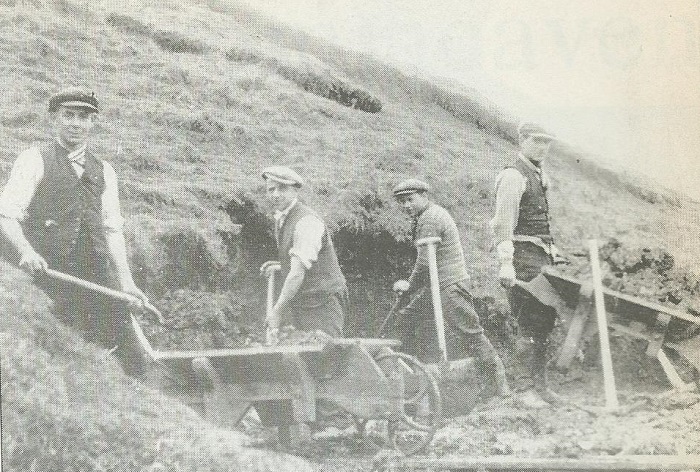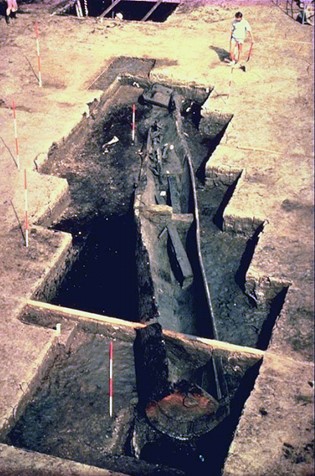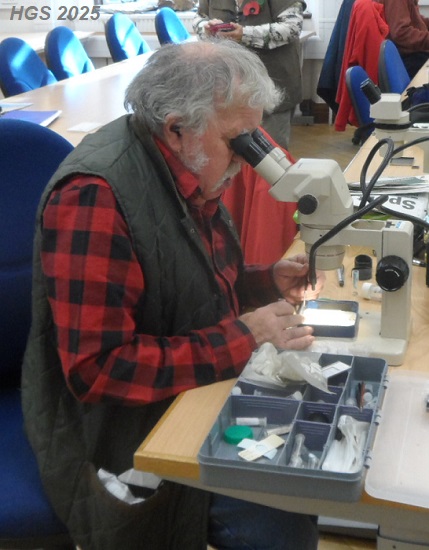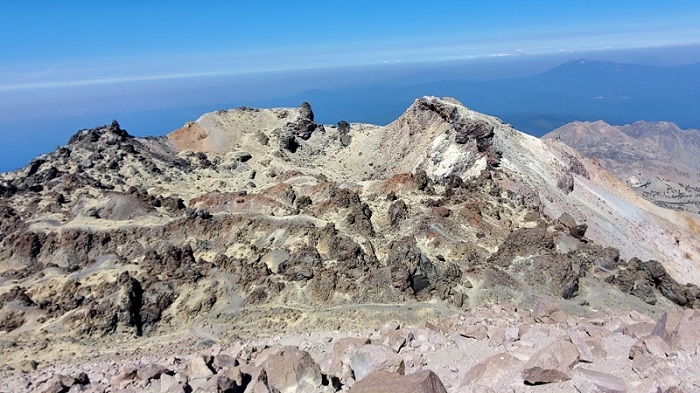
Hull Geological Society

News and abstracts
Copyright Hull Geological Society.
(updated 24th August 2025)

Saturday 23rd August 2025- Roadshow at Hornsea Museum
It was very busy at the Roadshow at Hornsea Museum from before the official opening until 1-30pm when it became a little quieter. There were displays of specimens by Mary Howard, Jack and Brenda Almond, Mick Oates and David Whipp. Mike Horne was the "expert" on the Finds Desk. The event was organised by Lewis Rose.
-o0o-
Thursday 3rd July 2025 - talk
by Philip Vixsebroxse
Abstract – “The
Ediacaran period - approximately 635 to 539 million years before present -
represents a critical period in Earth history. Preceding the Cambrian Explosion
of animal life, the Ediacaran holds significant promise in understanding the
evolutionary mechanisms leading up to the radiation of modern animal groups.
However, reconciling the bizzare body plans of the Ediacaran Biota with modern
animal groups has been contentious - though consensus is beginning to emerge. In
this talk, we will explore the exceptional fossil record of early soft-bodied
organisms, and discuss how they may relate to modern animal groups. We highlight
recent debate regarding their exceptional preservation, and outline novel
experimental work that sets out to test these competing hypotheses. Finally, we
look at the Ediacaran biota in a broader context, as a diverse, animal-dominated
community that "set the stage" for the Cambrian Explosion.”
Yorkshire Geology Month 2025 - there were nine events for Yorkshire Geology Month and eight of them are organised by HGS members -
24th April - Lecture by Paul Hildreth about Lincolnshire Limestone" (see below).
26th April - Yorkshire Geology Day at the National Coal Mining Museum, including a Chalk talk by Paul Hildreth.
7th May - Zoom lecture by Mike Horne about Thomas Sheppard.
11th May - walk in Hull's Western Cemetery led by Mike Horne.
18th May - field trip to RSPB Bempton and North Landing led by Paul Hildreth.
21st May - urban geology walk in York led by Paul Hildreth.
23rd May - scenic walk at Wold Newton, Lincolnshire, led by Martin Longshaw.
25th May - beach walk at Hornsea, led by Brenda and Jack Almond.
Report on the HGS contributions to YGM 2025 -
Seven members attended Paul Hildreth's talk about the ironstones of Lincolnshire. Paul described the geology of the Lower Jurassic and Lower Cretaceous ironstones, the history of their mining and assocaited social history.
Thirteen members and guests joined the Zoom talk about Thomas Sheppard by Mike
Horne. The talk was recorded so if you missed it and would like to listen,
please contact the Secretary.
Seven members and guests joined the “rocks in the cemetery” walk in Western
Cemetery (west) as part of Yorkshire Geology Month led by Mike Horne. As well as
looking at various rocks used for monuments we did a bit of history too:
visiting the graves of those killed in the Baltic Outrage of 1904 and the R38
airship crash memorial.
Five members attended the Wold Newton walk led by Martin Longshaw. We had lively
discussions about the dry valleys and glaciations, as well as experiencing
wonderful views of the Humber estuary and coast.
-o0o-
Thursday 24th April 2025 -
Paul Hildreth on
"Lincolnshire Ironstones".

Abstract -
Lincolnshire is probably not the first county of
England one might associate with heavy industry or the supply of raw materials
to such activities but it possesses several examples of iron ores that have
historically been important to the nation’s iron and steel production.
This talk will focus on the three most significant of
the county’s deposits, the Frodingham (Lower Jurassic), Northampton Sand (Middle
Jurassic) and Claxby (Lower Cretaceous) ironstones, their stratigraphy and
palaeogeography and a brief history of the associated extractive and processing
industries. Illustrations will include historical documents, maps and
photographs as well as personal in-the-field observations. A selection of
specimens will be available on the night for close examination.
-o0o-
Wednesday 19th March 2025 – Evening Zoom
Talk
Abstract – Previous excursions to try to nail down this famous angular
unconformity focused on where it can be seen, or imagined, around the great
limestone hill of Moughton. But there are other nearby locations, usually
related to the North Craven Fault, where we can get a glimpse of this
unconformity – in Crummackdale and in waterfalls on several becks flowing
southwards from Ingleborough.
As well as the unconformity, there are interesting rocks in and around
Crummackdale to look out for – the Moughton Whetstone and the Norber
Erratics. And though no longer seen at the surface, the former Ingleton
Coalfield sits on the downthrown side of the Craven Fault System – the major
structure which defines the landscape along much of the southern edge of the
Yorkshire Dales National Park.
-o0o-

Thursday 13th March 2025 - Dr Peter Halkon of Hull University “The
changing Landscape of the Foulness Valley, East Yorkshire”
A
For over 40
years the speaker has been researching the wider landscape around this little
known East Riding river. Brought up on a farm at Hasholme,
Holme-on-Spalding Moor, he gained an interest in archaeology at an early age,
picking up Roman pottery on one of his father's fields. In 1980 Peter
established a landscape archaeology project through the East Riding
Archaeological Society and from 1983 to 2015 in collaboration with Professor
Martin Millett. Major discoveries included the Hasholme Iron Age log boat, one
of the UK largest Iron Age iron production regions, Roman pottery kilns and
Roman roadside settlements at Hayton and Shiptonthorpe. Although the main focus
was on later prehistory and the Roman period, it became clear that there was
much evidence for earlier human activity within this landscape.
Palaeoenvironmental analysis demonstrated major changes particularly
the effect of marine transgression and regression on human/landscape interaction
which is of relevance today, as we face another period of sea level rise and
climate change.
-o0o-

Stuart Jones FGS,
our President, passed away on 8th February after a short illness.
Stuart joined the Society in 2000. He was our
President 3 times, Vice-President twice and our Librarian for 22 years. Stuart
was an active member in our research projects such as the Flamborough Quaternary
Research Group and a key member in our conservation team at Rifle Butts SSSI. He
was awarded the Felix Whitham Memorial Medal in 2013. Stuart has been the
organiser of the Rock and Fossil Roadshow at Hornsea Museum since 2007 and more
recently Roadshows at Flamborough Village Hall. Stuart has led numerous field
meetings for the Society and always displayed fossils at conferences and joint
meetings with the Yorkshire Geological Society and Geologists’ Association.
"Poor Stuart – we will miss him.
-o0o-
Wednesday 19th
Febuary 2025 – Evening Zoom Talk
Abstract
– The striking difference between most of the parish churches of Holderness and
other parts of Yorkshire is that they’re built partially – sometimes mainly - of
cobbles from the beaches along the nearby North Sea coast. Why this is the case
is obvious when you consider that the land surface of Holderness is 100% glacial
till, with no outcrops of hard rock whatsoever. Churches were the first
buildings of stone, along with castles, following the Norman invasion of the 11th
century – there was a boom in such buildings as the new regime sponsored them to
be effectively the administrative and social centres of all the communities, not
just in Yorkshire but in the whole country.
Much of the finance and labour needed to design and
build these churches came from local sources – as did the building materials.
The problem in Holderness was that the essential cornerstones – the quoins – of
churches and other stone buildings must be made of strong, hard rock that can be
“dressed” or easily shaped by stone masons.
Holderness
had (and has) none of this type of rock. So, this relatively small volume of the
church’s structure had to be built with rock, usually a sandstone or a
limestone, imported from other parts of Yorkshire. However, the rest of the
building could be, and was, built of either less robust material, such as brick,
or rounded cobbles, which were and still are found on our beaches. The result
was that Holderness has hundreds of buildings, both churches and other
structures, that are an eclectic mixture of a variety of mainly locally
available materials.
This talk will attempt to catalogue most of those building materials then used
in Holderness, where they came from and, in the case of some of the most
prominent and famous buildings, who financed them. There will also be a short
history of brick making in Hull and Holderness – one of the earliest places to
make bricks in England, because of the shortage or absence of other materials
and because there was an abundant source of good brick-making clay from the
alluvium of the Humber and Hull valleys.
-o0o-
Wednesday 15th January 2025 -
“Mt Lassen & Other Volcanoes
of the Southern Cascades”

Abstract
– Mt Lassen is the southernmost of a long chain of active volcanoes that
stretches from northern California to southern British Columbia – a distance of
about 1250 kms. By “active” we mean that several have erupted in living memory,
and all have periodic seismic activity that could be the precursor to an
eruption. The whole chain’s origin is closely related to the collision and
subsequent subduction of the Pacific Plate beneath the North American plate,
with these volcanoes’ magma forming when the Pacific Plate’s rocks have
descended far enough and deeply enough to melt.
The material erupted from these strata-volcanoes results in almost the whole
range of volcanic rocks. This talk will describe the Cascade Volcanic “process”
and illustrate with photos the current structural topography of several of these
mountains at the south end of the chain, plus their erupted volcanic rocks now
at the surface. Specifically, there will be a detailed look at Mt Lassen, with
photos from several hikes up & around this peak.
The Committee has decided that the annual subscription for 2025 will be £10.00 for all members (including Family Membership). Please assist the Treasurer by paying your subs promptly. We will also be asking members for their current contact details and preferences so that we can update out databases.
Copyright - Hull Geological Society 2025
Copyright Hull Geological Society.
Registered Educational Charity No. 229147